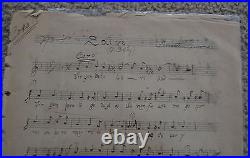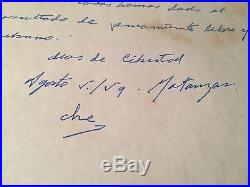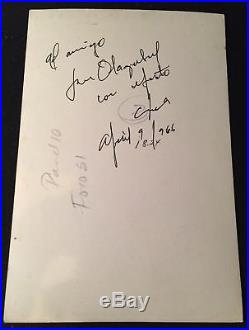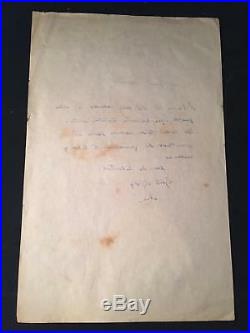



Boldly penned autograph musical manuscript, one page both sides, 10.25 x 13.5, signed in the upper right, “Ernesto Lecuona, ” and titled, Salve. Lecuona pens over 50 bars of music and Spanish lyrics for the song, an impassioned prayer asking for the protection of the Virgin of Charity, Patroness of Cuba. In fair condition, with scattered toning and dampstaining, chipping and tears to edges, and some of the writing affected by moisture exposure. Ernesto Lecuona y Casado Spanish pronunciation: e? Nesto le’kwona; August 6, 1895 – November 29, 1963 was a Cuban composer and pianist of worldwide fame. He composed over six hundred pieces, mostly in the Cuban vein, and was a pianist of exceptional skill. [1][2] His father was Canarian and his mother was Cuban. Contents 1 Biography 2 Selected compositions 2.1 Waltz 2.2 Others 3 See also 4 References 5 External links Biography Lecuona was born in Guanabacoa, Havana, Cuba. He started studying piano at an early age, under his sister Ernestina Lecuona, a famed composer in her own right. As a child prodigy, he composed his first song at the age of 11. [3] He later studied at the Peyrellade Conservatoire under Antonio Saavedra and the famous Joaquín Nin. Lecuona graduated from the National Conservatory of Havana with a Gold Medal for interpretation when he was sixteen. He performed outside of Cuba at the Aeolian Hall (New York) in 1916. In 1918 he collaborated with Luis Casas Romero, Moisés Simons, Jaime Prats, Nilo Menéndez and Vicente Lanz in setting up a successful player piano music roll factory in Cuba producing Cuban music and also copies from masters made by QRS in the USA. The brand label was “Rollo Autógrafo” Ernesto Lecuona: dedicated to Gonzalo Roig He first travelled to Spain in 1924 on a concert tour with violinist Marta de la Torre; his successful piano recitals in 1928 at Paris coincided with a rise in interest in Cuban music. María la O, Lecuona’s zarzuela, premiered in Havana on March 1, 1930. He was a prolific composer of songs and music for stage and film. His works consisted of zarzuela, Afro-Cuban and Cuban rhythms, suites and many songs which are still very famous. They include Siboney (Canto Siboney), Malagueña and The Breeze And I (Andalucía). In 1942, his great hit, Always in my heart (Siempre en mi Corazón) was nominated for an Oscar for Best Song; however, it lost to White Christmas. Lecuona was a master of the symphonic form and conducted the Ernesto Lecuona Symphonic Orchestra, employing soloists including Cuban pianist and composer Carmelina Delfín. The Orchestra performed in the Cuban Liberation Day Concert at Carnegie Hall on October 10, 1943. The concert included the world premiere of Lecuona’s Black Rhapsody. Lecuona gave help and the use of his name to the popular touring group, the Lecuona Cuban Boys, though he did not play as a member of the band. He did sometimes play piano solos as the first item on the bill. In 1960, thoroughly unhappy with Castro’s new régime, Lecuona moved to Tampa and lived on West Orient Street with his relative, singer Esperanza Chediak. Lecuona lived his final years in the US. Three years later, on November 29, 1963 he died at the age of 68 in Santa Cruz de Tenerife, in the Canary Islands, as a result of an attack of asthma, a disorder which had persecuted him his entire life. [4] He was interred at Gate of Heaven Cemetery in Hawthorne, New York, but his will instructs that his remains be repatriated once the current régime runs its course. A great deal of Lecuona’s music was first introduced to mass American audiences by Desi Arnaz, a fellow Cuban and Lucille Ball’s spouse. Ernesto Lecuona circa 1935 Lecuona’s talent for composition has influenced the Latin American world in a way quite similar to George Gershwin in the United States, in his case raising Cuban music to classical status. Ernesto and Ernestina’s cousin Margarita Lecuona was another accomplished musician and composer. She was the author of the song “Babalú”, made popular in the Latin American world by Miguelito Valdés, and in the United States by Desi Arnaz (who, contrary to popular folklore, did not write the song). Lecuona was included as a character in the novel The Island of Eternal Love, by Miami-based Cuban writer Daína Chaviano, together with other important names in Cuban music. Selected compositions For piano Suite Andalucía Córdova/Córdoba Andalucía/Andaluza Alhambra Gitanerías Guadalquivir Malagueña San Francisco El Grande Ante El Escorial Zambra Gitana Aragonesa Valencia Mora Aragón Waltz Si menor (Rococó) La bemol Apasionado Crisantemo Vals Azul Maravilloso Romántico Poético Others Afro-Cuban suite Ahí viene el chino Al fin te vi Amorosa Andar Aquí está Arabesque Bell Flower Benilde Burlesca Canto del guajiro Cajita de música Como el arrullo de palma Como baila el muñeco Dame tu amor Danza de los Ñáñigos Danza Lucumí Diario de un niño Ella y yo ¡Échate pa’llá María! El batey El miriñaque El sombrero de yarey El tanguito de Mamá (también llamada A la Antigua) En tres por cuatro Eres tú el amor Futurista Gonzalo, ¡no bailes más! Impromptu La 32 La primera en la frente La Comparsa La conga de medianoche La Habanera La danza interrumpida La mulata La negra Lucumí La Cardenense Los Minstrels Lola Cruz Lola está de fiesta Lloraba en sueños Mazurka en glissado Melancolía Mientras yo comía maullaba el gato Mis tristezas Malagueña Muneca de Cristal Muñequita Negra Mercé Negrita ¡No hables más! No me olvides No puedo contigo Noche Azul Orquídeas Pensaba en ti Polichinela ¿Por qué te vas? Preludio en la noche ¡Que risa me da! Mi abuela bailaba así Rapsodia Negra Rosa, la china Tú serás Tres miniaturas ¡Y la negra bailaba! ¡Y sigue la lloviznita! Yo soy así Yumurí Zapateo y guajira Zenaida. Ernesto Lecuona was the most important musician in Cuban musical life during the first half of the 20th century. Born in Guanabacoa, a suburb of Havana, in 1895, Lecuona first established himself as an outstanding pianist, graduating from the National Conservatory with the Gold Medal in performance at the age of seventeen. He went to New York City to concertize and there, in 1916, made his first public appearance outside of Havana. International success as a pianist occurred seven years later, once more in New York but, thanks to the huge success of pieces like. Composition superceded pianism as Lecuona’s primary activity. Still, Lecuona continued to actively tour and perform widely as pianist and conductor for most of his life. Among Lecuona’s many achievements were the founding of the Havana Symphony (with Gonzalo Roig), the Lecuona Cuban Boys Band, and La Orquesta de La Habana. Lecuona, also, wrote a great deal of film music in the’30s and’40s for such major studios as MGM, 20th Century Fox and Warner Brothers; in 1942, he was nominated for an Academy Award. Cuban-born, Ernesto Lecuona is the dominant musical force to have come out of the island nation, and without question one of the major contributors to the emergence of Latin music as a power in the world marketplace. Often called’the Gershwin of Cuba,’ he was friendly with George Gershwin and with the composer Maurice Ravel, who once called Lecuona’s immortal “Malaguena, ” “more melodic and beautiful than my own “Bolero. Lecuona was friendly with many of the most influential composers and musical personalities of his moment in time, and his style and use of forms have influenced all Latin music, even the salsa of today. Ernesto Lecuona was born in Guanabacoa, Cuba, across the bay from Havana, on August 6, 1895, but for an unexplained reason he actually observed his birthday as August 7, 1896. His musical talent was already discernible at age three. Following initial piano studies with his sister, Ernestina, he continued at the Conservatorio Peyrellade with Antonio Saaverda and the famed Joaquin Nin. At 17 he graduated from the National Conservatory of Havana with a gold medal in performance. He had become a prodigious pianist indeed and his talents were soon on view for the first time outside Cuba when he appeared at Aeolian Hall, New York City in 1916. While his ties to his native Cuba were always strong, this initial performance in New York paved the way for an increasing presence in the United States, both as concert pianist and as composer, which eventually led to his permanent move to Florida in 1960, following the rise to power of the Communist leader, Fidel Castro in 1959. Lecuona produced a veritable torrent of music during his 70 years, including a number of major pop songs, such as the well-remembered, “Malaguena” the bright and rhythmic, “Siboney, ” with which one can almost hear the clicking accompaniment of castanets “Always in My Heart” and “Andalucia, ” better remembered for its Americanized version, “The Breeze and I, ” which became in the late’30s a popular recording hit by the Jimmy Dorsey Orchestra. While we honor the late Ernesto Lecuona for his wonderful collection of memorable and tuneful songs, his talents in music-making were literally all over the map. In addition to more than 400 songs, he also created 176 piano pieces, 53 theater works (zarzuelas, operettas, theatrical revues and an opera), 31 orchestral scores, 6 pieces for piano and orchestra, 3 violin works, a trio, 5 ballets, 11 film scores and many incidental arrangements. Lecuona’s work stretched considerably beyond the printed score sheet. He was the co-founder of the Havana Symphony Orchestra, the Lecuona Cuban Boys Band and La Orquesta de la Habana. During the’30s and’40s, he was hired to create a number of motion picture scores for MGM, Warner Bros. And 20th Century Fox, and his score for the 1942 Warner Bros. Always in My Heart. Was nominated for an Academy Award. At one time he also served as honorary cultural attaché to the Cuban embassy in Washington. He also gave successful performances in Carnegie Hall. Lecuona, who had moved permanently to Tampa, Florida in 1960, died three years later of a heart attack while on a trip to Santa Cruz de Tenerife in the Canary Islands. He is buried in the Gate of Heaven Cemetery in Hawthorne, NY. Born 6 August 1895, Guanabacoa, Cuba. Died 1963, Tenerife, Canary Islands. E rnesto Lecuona is major, if not well-known, figure in popular music of this century. He brought the first successful Latin orchestra to the United States, fostered the careers of many of the most influential artists in Latin music, and composed many of its most enduring songs. He achieved the rare distinction of both popular and critical success, competing with the best of Tin Pan Alley as a songwriter while at the same time making his mark as a contemporary classical composer. The son of a newspaper editor, Lecuona was taught piano by his older sister, Ernestina. All of his siblings–two sisters and two brothers–were musicians, and he was a child prodigy, debuting at the age of five. He attended the National Conservatory in Havana and received his certificate at the age of 15. He studied with Ravel in Paris briefly, then played recitals in the U. His first major composition, “Malaguena, ” was introduced by Lecuona at the Roxy Theatre in New York in 1927. “Andalucia, ” published in 1930, was later reintroduced with English lyrics as “The Breeze and I” in 1940. Following the success of Don Azpiazu’s Havana Casino Orchestra, the first major Latin group to perform in the U. Lecuona formed the Palau Brothers Cuban Orchestra, and later renamed it the Lecuona Cuban Boys. This group met with great success in the U. And Europe before disbanding the band in the mid 1930s and appeared in the early sound film, Cuban Love Song. Lecuona wrote in virtually every form, from cantatas to piano pieces, but his songs are by far the best remembers works. BMI lists “The Breeze and I” as a having received over one million airplays. Among his other popular songs are “Dust on the Moon, ” “Say Si Si, ” “Jungle Drums, ” “Always in My Heart, ” “Siboney, ” “La Comparsa, ” and Maria My Own (Maria O Lao). Lecuona was among the leading composers in early sound films, writing scores for numerous American and Latin American movies, including. “Under Cuban Skies, ” MGM (1931). “Free Soul, ” MGM (1931). “Susana Lenox, ” MGM (1931). “Pearl Harbor, ” MGM (unknown year). “La Cruz y La Espada” (The Cross and The Sword), MGM (unknown year). “Always in My Heart, ” Warner Bros. (1942) Title song was Oscar nominee for Best Song. “One More Tomorrow, ” Warner Bros. “Carnival in Costa Rica, ” 20th Century Fox (1947). “Maria La O” (Mexican film, unknown year). “Adios, Buenos Aires” (Argentine film, unknown year). “La Ultima Melodia” (Cuban film, unknown year). Lecuona was named honorary cultural attache to the Cuban embassy in Washington in 1943 in recognition of his work as a cultural ambassador from Cuban. He performed only occasionally after that, though. One might say that he anticipated the percussion craze with his 1943 work, “Black Rhapsody, ” which called for the orchestra to use “una quijada”–the jawbone of an ass. Lecuona lived exclusively in ranches and farms in Cuba, raising small animals and exotic birds in his spare time. A lifelong bachelor, he pursued hobbies ranging from collecting antiques, cigarette lighters, and music boxes, reading Agatha Christie mysteries, following Cuban and American baseball leagues, and playing poker. He left Cuba for good in 1960 and vowed never to play again until Cuba was free from Castro and communism. He maintained residences in New York City and Tampa and Tallahassee, Florida. He died in the Canary Islands after travelling there to vacation and attend a concert in his honor. He was buried at the Gates of Heaven Cemetery in Long Island. Lecuona Plays Lecuona, RCA Victor CD 1055-2-RL. Ernesto Lecuona at the Piano with his Orchestra and his Interpreters, Funny CD 541. Ernesto Lecuona: The Complete Piano Music, Vol. This item is in the category “Collectibles\Autographs\Music”. The seller is “memorabilia111″ and is located in this country: US. This item can be shipped to United States, Canada, United Kingdom, Denmark, Romania, Slovakia, Bulgaria, Czech Republic, Finland, Hungary, Latvia, Lithuania, Malta, Estonia, Australia, Greece, Portugal, Cyprus, Slovenia, Japan, China, Sweden, South Korea, Indonesia, Taiwan, South Africa, Thailand, Belgium, France, Hong Kong, Ireland, Netherlands, Poland, Spain, Italy, Germany, Austria, Bahamas, Israel, Mexico, New Zealand, Singapore, Switzerland, Norway, Saudi Arabia, United Arab Emirates, Qatar, Kuwait, Bahrain, Republic of Croatia, Malaysia, Brazil, Chile, Colombia, Costa Rica, Panama, Trinidad and Tobago, Guatemala, Honduras, Jamaica, Barbados, Bangladesh, Bermuda, Brunei Darussalam, Bolivia, Ecuador, Egypt, French Guiana, Guernsey, Gibraltar, Guadeloupe, Iceland, Jersey, Jordan, Cambodia, Cayman Islands, Liechtenstein, Sri Lanka, Luxembourg, Monaco, Macau, Martinique, Maldives, Nicaragua, Oman, Peru, Pakistan, Paraguay, Reunion, Vietnam.
















